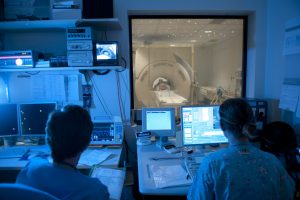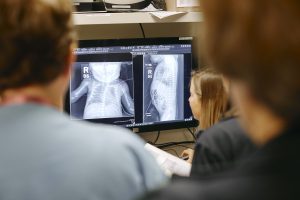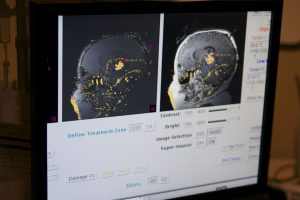Radiologists are health professionals who use imaging techniques to diagnose various patient conditions. While you’re probably familiar with some, there are many different types of radiology specialties, each with its tools and methodologies. Explore the radiology specialties list below for more inspiration if you’re looking into medical imaging careers.
There are plenty of medical imaging career paths available to those interested in radiology. In the same way that other medical professionals can specialize in their areas of interest, you can choose from different branches of radiology as well. The best way to decide what radiology fields will best suit you is to learn more about each specialty and what it entails.
Radiologists are health professionals who use imaging techniques to diagnose various patient conditions. While you’re probably familiar with some, there are many different types of radiology specialties, each with its tools and methodologies. Explore the radiology specialties list below for more inspiration if you’re looking into medical imaging careers.
There are plenty of medical imaging career paths available to those interested in radiology. In the same way that other medical professionals can specialize in their areas of interest, you can choose from different branches of radiology as well. The best way to decide what radiology fields will best suit you is to learn more about each specialty and what it entails.
Medical imaging careers
Below are five of the leading medical imaging careers. These are specialized topics in areas of radiologic sciences that people most often encounter during their journeys to achieve medical diagnoses.
Radiologic technologist (RT)
X-ray (radiography) professionals produce internal images of a person’s body. X-rays use tiny, safe doses of ionizing radiation to accomplish this. As a result, X-rays are more common than other types of medical imaging.
CT technologist
A CT scan creates multiple images of the body’s internal structures, like x-rays. However, CT scans can be viewed on numerous planes or as three-dimensional images. As a result, they provide a care team with greater detail and information than traditional x-rays.
Fluoroscopy operator
Fluoroscopy is like an x-ray in movie format. An x-ray beam continuously passes through an area of the body, transmitting to a monitor for the radiologist to view. For body parts that move, fluoroscopy can provide medical imaging professionals with detail that still images cannot.
Ultrasound technologist
Ultrasounds use sonography to produce internal images of the body. Sonograph professionals use transducers or probes to send sound waves through a person’s body, creating clear pictures for the sonographer to view. Ultrasounds produce no radiation.
MRI technologist
Magnetic resonance imaging (MRI) uses a large, powerful magnet and radio waves to produce internal images of a person’s body. MRIs often result in more detailed images than other imaging techniques can achieve. Thanks to these ultra-clear images, MRIs can detect critical issues in the body.
Diagnostic radiology vs. interventional radiology
Two main categories of radiology are diagnostic and interventional radiology. The two different types of radiologists both work with technologically-advanced equipment to create internal images of patients to improve their health and wellness.
Diagnostic radiology focuses on creating images to identify issues a patient might be suffering. There are different types of diagnostic radiology that doctors can use to implement treatment plans and monitor the progression of diseases.
Pediatric interventional radiology uses medical imaging equipment to aid with minimally invasive surgery. In addition, interventional radiology can prevent the need for more invasive surgery.
Pediatric radiologists specialize in the diagnostic imaging of children. Pediatric radiologists use many imaging techniques and tools to capture images of children’s internal body structures to make diagnoses and treatment plans. Pediatric radiology professionals must consider how children differ from adults when retrieving their scans and images.
- Children’s bodies are still developing and are more sensitive to radiation.
- Young children may find specific imaging equipment frightening.
- Children’s scans look different than adult scans and will read differently.
- Children often find it difficult to verbalize what is wrong.
11 radiology specialties to explore
Pediatric radiology
Pediatric radiologists specialize in safely performing imaging techniques on infants, children, and teenagers. These images inform diagnoses and treatment plans. In addition, since children have needs different from adults, pediatric professionals address their patients with extra gentleness and care.
Musculoskeletal radiology (MSK)
Musculoskeletal radiologists use radiology techniques and equipment to gather images of patients’ muscles, spine, joints, and bones. People of all ages and lifestyles can suffer from injuries and diseases to these areas in the body. These are much easier to find, diagnose, and treat with MSK radiology.
Neuroradiology
Neuroradiology allows radiologists of this specialty to procure brain images using technologies including x-ray, MRI, CT, and ultrasound. These images of a patient’s brain’s structure and activity allow doctors to diagnose and treat neurological conditions and disorders. The head, brain, neck, and spine are viewed during neuroradiology scans.
Head and neck radiology
Head and neck radiology sounds like neurobiology, but it differs slightly. Unlike neuroradiology, head and neck radiology does not focus on the brain or spinal cord structures. Instead, head and neck radiology concentrates solely on the anatomical structures in the head and neck region.
Genitourinary radiology
Genitourinary radiologists take images of the urinary system and the male reproductive system. The urinary photos capture the kidneys, bladder, and adrenal glands and help doctors diagnose diseases and conditions of the urinary tract. Genitourinary radiologists often work closely with urologists during the diagnostic process.
Gastrointestinal (GI) radiology
Gastrointestinal radiologists use imaging techniques to capture internal images of a patient’s digestive tract, including the stomach, intestines, liver, and pancreas. These images can help locate issues and diagnose diseases. Radiologists that specialize in GI radiology often work closely with gastroenterologists
Emergency radiology
Emergency radiology is medical imaging that occurs in an emergency room. Often, patients enter the emergency room suffering from acute illness and injury, but the exact cause is unclear. Emergency radiologists work alongside emergency physicians to search for internal damage to these patients’ bodies via different medical imaging technologies.
Chest radiology
There are many organs and bodily structures within the chest. These include the heart, lungs, ribs, and spine. Chest radiology allows these specialty radiologists to view these internal structures and find any issues with the heart, blood vessels, airways, bones, or other chest components.
Cardiovascular radiology
Cardiovascular radiology focuses on collecting images that can pinpoint or diagnose cardiovascular system diseases. Cardiovascular radiologists use imaging technologies to gather internal scans of a patient’s heart and blood vessels, allowing them to diagnose and monitor heart disease or vascular disease.
Bone densitometry
Bone densitometry measures a person’s bone loss, usually in the case of a patient with osteoporosis. This rad tech specialty also helps diagnose osteoporosis. Bone densitometry uses small dose x-rays to create images of a person’s bones, especially where osteoporotic fractures are likely to occur.
Radiation oncology
Radiation oncologists are radiologists who choose to use their knowledge of radiation to specialize in treating cancer and other diseases that require radiation. Radiation oncologists often work alongside oncologists and surgeons, using their imaging techniques to create the best possible care plan for those who need radiation treatment.



What can you do with a degree in medical imaging?
Not every career in medical imaging requires a degree. However, in many cases, excellent, high-paying careers in medical imaging are available to those who have received higher education programs in these specialized topics in areas of radiologic sciences. A few examples include:
- Radiation therapist: Radiation therapy administers radiation treatments to patients with certain diseases, such as cancer, as part of their treatment plans. The median salary for radiation therapists in May 2020 was $86,850 according to the bureau of labor statistics.
- Nuclear medicine technologist: Nuclear medicine technologists handle and administer radioactive substances to patients in preparation for imaging or as part of their treatment plans. The median salary for nuclear medicine technologists in May 2020 was $79,590.
- Diagnostic medical sonographer: Diagnostic medical sonographers operate imaging equipment to create necessary images for patient health records. The median salary for diagnostic medical sonographers in May 2020 was $70,380.
Pediatric medical imaging jobs at Children’s Minnesota
As you can see, the careers in radiology are plentiful and varied. However, if you’re considering entering the field, take the time to weigh different specialties and how well they would suit you as a professional; At Children’s Minnesota, we are a leader with pediatric patients.
Our pediatric radiology team offers children and their families the peace of mind that comes with great care and state-of-the-art tools and techniques. Whether you are becoming a medical doctor or finishing a Bachelor’s degree in medical imaging, the radiology program at Children’s Minnesota has room for compassionate, hard-working, dedicated professionals like you.
Learn more about the benefits to working at Children’s Minnesota
Children’s Minnesota, which serves more than 130,000 patients annually, is committed to providing everyone the care and attention they need to be successful in health and in life. We want all who engage with us — patients, families, employees, vendors and community partners — to feel valued, respected and supported. That means having a diverse, equitable and inclusive culture that reflects the rich backgrounds of the communities we serve. Having this culture brings about better communication, improves access to care, cultivates deeper patient satisfaction, reduces health disparities and creates an engaging place to work.
We know that taking care of the most amazing people starts with taking care of ourselves. Children’s Minnesota offers comprehensive benefits for our employees and their families. Ready to join the team of kid experts?